Human alkyladenine DNA glycosylase employs a processive search for DNA damage
- PMID: 18839966
- PMCID: PMC2702167
- DOI: 10.1021/bi801046y
Human alkyladenine DNA glycosylase employs a processive search for DNA damage
Abstract
DNA repair proteins conduct a genome-wide search to detect and repair sites of DNA damage wherever they occur. Human alkyladenine DNA glycosylase (AAG) is responsible for recognizing a variety of base lesions, including alkylated and deaminated purines, and initiating their repair via the base excision repair pathway. We have investigated the mechanism by which AAG locates sites of damage using an oligonucleotide substrate containing two sites of DNA damage. This substrate was designed so that AAG randomly binds to either of the two lesions. AAG-catalyzed base excision creates a repair intermediate, and the subsequent partitioning between dissociation and diffusion to the second site can be quantified from the rates of formation of the different products. Our results demonstrate that AAG has the ability to slide for short distances along DNA at physiological salt concentrations. The processivity of AAG decreases with increasing ionic strength to become fully distributive at high ionic strengths, suggesting that electrostatic interactions between the negatively charged DNA and the positively charged DNA binding surface are important for nonspecific DNA binding. Although the amino terminus of the protein is dispensable for glycosylase activity at a single site, we find that deletion of the 80 amino-terminal amino acids significantly decreases the processivity of AAG. These observations support the idea that diffusion on undamaged DNA contributes to the search for sites of DNA damage.
Figures

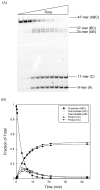

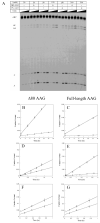
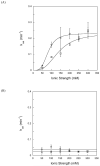
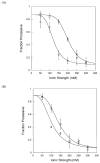

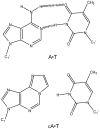

Similar articles
-
Search for DNA damage by human alkyladenine DNA glycosylase involves early intercalation by an aromatic residue.J Biol Chem. 2017 Sep 29;292(39):16070-16080. doi: 10.1074/jbc.M117.782813. Epub 2017 Jul 26. J Biol Chem. 2017. PMID: 28747435 Free PMC article.
-
Distinguishing Specific and Nonspecific Complexes of Alkyladenine DNA Glycosylase.Biochemistry. 2018 Jul 31;57(30):4440-4454. doi: 10.1021/acs.biochem.8b00531. Epub 2018 Jul 16. Biochemistry. 2018. PMID: 29940097 Free PMC article.
-
Recognition and processing of a new repertoire of DNA substrates by human 3-methyladenine DNA glycosylase (AAG).Biochemistry. 2009 Mar 10;48(9):1850-61. doi: 10.1021/bi8018898. Biochemistry. 2009. PMID: 19219989 Free PMC article.
-
Structural studies of human alkyladenine glycosylase and E. coli 3-methyladenine glycosylase.Mutat Res. 2000 Aug 30;460(3-4):201-10. doi: 10.1016/s0921-8777(00)00027-6. Mutat Res. 2000. PMID: 10946229 Review.
-
Insights into the glycosylase search for damage from single-molecule fluorescence microscopy.DNA Repair (Amst). 2014 Aug;20:23-31. doi: 10.1016/j.dnarep.2014.01.007. Epub 2014 Feb 20. DNA Repair (Amst). 2014. PMID: 24560296 Free PMC article. Review.
Cited by
-
Exploring C-to-G and A-to-Y Base Editing in Rice by Using New Vector Tools.Int J Mol Sci. 2022 Jul 20;23(14):7990. doi: 10.3390/ijms23147990. Int J Mol Sci. 2022. PMID: 35887335 Free PMC article.
-
Critical role of DNA intercalation in enzyme-catalyzed nucleotide flipping.Nucleic Acids Res. 2014 Nov 10;42(20):12681-90. doi: 10.1093/nar/gku919. Epub 2014 Oct 16. Nucleic Acids Res. 2014. PMID: 25324304 Free PMC article.
-
Electrostatic control of DNA intersegmental translocation by the ETS transcription factor ETV6.J Biol Chem. 2017 Aug 11;292(32):13187-13196. doi: 10.1074/jbc.M117.792887. Epub 2017 Jun 7. J Biol Chem. 2017. PMID: 28592487 Free PMC article.
-
MPG and NPRL3 Polymorphisms are Associated with Ischemic Stroke Susceptibility and Post-Stroke Mortality.Diagnostics (Basel). 2020 Nov 13;10(11):947. doi: 10.3390/diagnostics10110947. Diagnostics (Basel). 2020. PMID: 33202874 Free PMC article.
-
Defining the functional footprint for recognition and repair of deaminated DNA.Nucleic Acids Res. 2012 Dec;40(22):11638-47. doi: 10.1093/nar/gks952. Epub 2012 Oct 15. Nucleic Acids Res. 2012. PMID: 23074184 Free PMC article.
References
-
- Ye N, Holmquist GP, O’Connor TR. Heterogeneous repair of N-methylpurines at the nucleotide level in normal human cells. J Mol Biol. 1998;284:269–85. - PubMed
-
- Cappelli E, Hazra T, Hill JW, Slupphaug G, Bogliolo M, Frosina G. Rates of base excision repair are not solely dependent on levels of initiating enzymes. Carcinogenesis. 2001;22:387–93. - PubMed
-
- Lindahl T. Instability and decay of the primary structure of DNA. Nature. 1993;362:709–15. - PubMed
-
- O’Brien PJ, Ellenberger T. Dissecting the broad substrate specificity of human 3-methyladenine-DNA glycosylase. J Biol Chem. 2004;279:9750–7. - PubMed
Publication types
MeSH terms
Substances
Grants and funding
LinkOut - more resources
Full Text Sources

